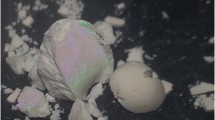Abstract
A cost-effective, one-pot synthesis approach is reported to fabricate Rhodamine 6G (R6G) silica hybrid xerogels. Polyvinyl alcohol (PVA) is used as a non-ionic surfactant to homogeneously trap the dye in silica matrix. Presence of R6G in silica matrix is confirmed through Fourier Transform Infrared (FTIR) spectroscopy and Thermo Gravimetric Analysis (TGA) studies. Hybrids containing larger amount of PVA are found to exhibit better thermal stability than the hybrids with lesser PVA content. Optical properties of the hybrids are analyzed via UV–visible spectroscopy, and it is discovered that hybrids containing larger amounts of PVA do not form aggregates. Uniform distribution of fluorophores in silica matrix helps to minimize formation of J-aggregates in the hybrids, therefore making them ideal candidates for use in dye lasers. The resultant hybrids can be ascribed as stable multicomponent systems that exhibit excellent monodispersity and brightness.







Similar content being viewed by others
References
Carbonaro CM, Anedda A, Grandi S, Magistris A (2006) Hybrid materials for solid-state dye laser applications. J Phys Chem B 110:12932–12937
Montalti M, Prodi L, Rampazzo E, Zaccheroni N (2014) Dye-doped silica nanoparticles as luminescent organized systems for nanomedicine. Chem Soc Rev 43:4243–4268
Wang H, Yang Q, Sun L, Wang S, Wang W, Zhang C, Li Y, Xu S, Li Y (2010) Aggregation states of rhodamine 6G in electrospun nanofibrous films. J Colloid Interface Sci 341(2):224–231
Blackman MJ, Corrie JET, Croney CJ, Kelly G, Ecclestor JF, Jameson DM (2002) Structural and biochemical characterization of a fluorogenic rhodamine-labeled malarial protease substrate. Biochemistry 41(40):12244–12252
Haghighat S, Castro DJ, Lufkin RB, Fetterman HR, Castro DJ, Soudant J, Ward PH, Saxton RE (1992) Laser dyes for experimental phototherapy of human cancer: comparison of three rhodamines. Laryngoscope 102(1):81–87
Innocenzi P, Hozuka H, Yoko TJ (1996) Dimer-to-monomer transformation of rhodamine 6G in sol-gel silica films. J Non-Cryst Solids 201(1):26–36
Saini GSS, Kaur S, Tripathi SK, Mahajan CG, Thanga HH, Verma AL (2005) Spectroscopic studies of rhodamine 6G dispersed in polymethylcyanoacrylate. Spectrochim Acta A 61:653–658
Malfatti L, Kidchob T, Aiello D, Aiello R, Testa F, Innocenzi P (2008) Aggregation states of rhodamine 6G in mesostructured silica films. J Phys Chem C 112(42):16225–16230
Bonacchi S, Genovese D, Juris R, Montalti M, Prodi L, Rampazzo E, Zaccheroni N (2011) Luminescent silica nanoparticles: extending the frontiers of brightness. Angew Chem Int Ed 50:4056–4066
Brinker CJ, Scherer GW (1990) Sol-Gel science, the physics and chemistry of sol-gel processing. Academic Press, New York
Avnir D, Levy D, Reisfeld R (1984) The nature of the silica cage as reflected by spectral changes and enhanced photostability of trapped Rhodamine 6G. J Phys Chem 88(24):5956–5959
Ekloff GS, Wohrle D, Duffel BV, Schoonheydt RA (2002) Chromophores in porous silicas and minerals: preparation and optical properties. Microporous Mesoporous Mater 51:91–138
Anedda A, Carbonaro CM, Clemente F, Corpino R, Ricci PC, Rossini S (2005) Rhodamine 6G impregnated porous silica: a photoluminescence study. Mater Sci Eng C 25:641–644
Grandi S, Tomasi C, Mustarelli P, Clemente F, Carbonaro CM (2007) Characterization of a new sol-gel precursor for a SiO2-rhodamine 6G hybrid class II material. J Sol-Gel Sci Technol 41:57–63
Cazade PA, Bordat P, Blanc S, Baraille I, Brown R (2008) Possible artifacts of fluorescence of dyes in concentrated materials: comment on highly fluorescent rhodamine B nanoparticles entrapped in hybrid glasses. Langmuir 24:2252–2257
Wang Y, Xu C, Ow H (2013) Commercial nanoparticles for stem cell labeling and tracking. Theranostics 3:544–560
Bhatt Y, Shah D (2012) Influence of additives on fabrication and release from protein loaded PLGA microparticles. J Chem Pharma Res 4(3):1707–1715
Schwertfeger F, Frank D, Schmidt M (1998) Hydrophobic waterglass based aerogels without solvent exchange or supercritical drying. J Non-Cryst Solids 225:24–29
Pirzada T, Shah SS (2014) Water-resistant poly(vinyl alcohol)-silica hybrids through sol-gel processing. Chem Eng Technol 37(4):620–626
Rao AP, Rao AV (2003) Studies on the effect of organic additives on the monolithicity and optical properties of the rhodamine 6G doped silica xerogels. Mater Lett 57:3741–3747
Pirzada T, Arvidson SA, Saquing CD, Shah SS, Khan SA (2012) Hybrid silica PVA nanofibers via sol-gel electrospinning. Langmuir 28:5834–5844
Gilliland JW, Yokoyama K, Yip WT (2004) Effect of Coulombic interactions on rotational mobility of guests in sol-gel silicate thin films. Chem Mater 16(20):3949–3954
Costa TMH, Benvenutti EV, da Jornada JAH (1997) Infrared and thermogravimetric study of high pressure consolidation in alkoxide silica gel powders. J Non-Cryst Solids 220:195–201
Koji N, Tomonori Y, Kenji I, Fumio S (1999) Properties and structure of poly(vinyl alcohol)/silica composites. J Appl Polym Sci 74(1):133–138
Vives S, Meunier C (2008) Influence of the synthesis route on sol-gel-SiO2-TiO2(1:1) xerogels and powders. Ceram Int 34:37–44
Costa TMH, Stefani V, Balzaretti NM, Gallas MR, de Jornada JAH (2010) High pressure entrapment of rhodamine 6G into silica matrix. Mol Cryst Liq Cryst 374:201–206
Acknowledgments
The authors are grateful to Centralized Resources Laboratory at the University of Peshawar, Pakistan, and the Chemical Engineering Department, NUST (Islamabad), respectively, for surface area and SEM analysis of the samples. Tahira Pirzada wishes to thank Higher Education Commission of Pakistan for financially supporting this project.
Author information
Authors and Affiliations
Corresponding author
Rights and permissions
About this article
Cite this article
Pirzada, T., Shah, S.S. Florescent silica PVA hybrids via sol–gel processing. Colloid Polym Sci 293, 3361–3368 (2015). https://doi.org/10.1007/s00396-015-3742-1
Received:
Revised:
Accepted:
Published:
Issue Date:
DOI: https://doi.org/10.1007/s00396-015-3742-1




